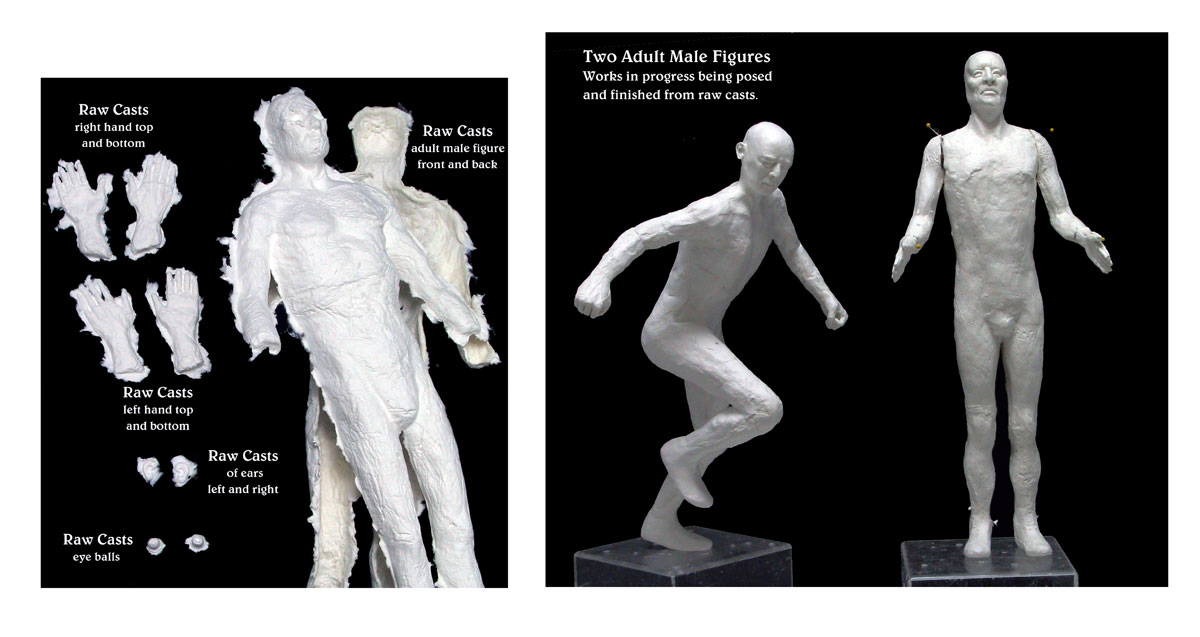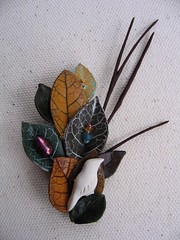by Guest Author Kathryn Gray of
Templewood Miniatures
Cold Porcelain paste is a lovely medium to work with. It does not have to be oven baked as it air dries – depending on the air humidity, it becomes completely dry between 2 – 3 hours.
Cold Porcelain can be rolled and worked much finer than pastes which have to be oven baked. It has a shrinkage rate of about 12%.
Cold Porcelain dries out very quickly and must always be wrapped tightly in cling film and then placed in a plastic bag which is then put into an airtight box when not being used.
It is important that a small quantity of white acrylic paint is added to the CP paste as you mix it - even if you intend to colour the paste - or it will be translucent when it dries. The semi-transparent characteristic of homemade Cold Porcelain is lovely if you want to make the aerial roots on orchids but not for anything else. White should be done before any other colour is added.
It is advisable to lightly colour CP paste with your chosen colour before starting to work with it. You can colour up with acrylic paint, sugar paste colours or craft dust. Once coloured up, wrap well and leave for about half an hour for it to ‘rest’ before use. Wrap colours separately in cling film, in order to avoid colour bleeding between the different pieces.
Do not colour up to much paste, as it does not keep as long once colour has been added. Uncoloured paste will last up to a year if stored correctly as described above.
You will need very little paste for mini projects; a piece about the size of a thumbnail will make about 20 leaves.
Before starting a project rub dab your board, rolling pin and cutters with cornflour (corn starch) - this ensures that the cold porcelain does not stick to anything – do not over dust, just enough to stop sticking. Make and use the bag system described below.
It is important to have a corn flour "dusting" bag (corn starch) available. I usually make this up by making a small bag with a piece of j-cloth, muslin or lint, put some powder into it and tie the top with a rubber band. Tools should be dabbed with this before use – it ensures that the paste does not stick – it does not get absorbed into the paste and can be dusted off when the paste is dry.
To work the CP paste, take a small amount of the coloured paste and roll out very thinly and use a cutter directly over the paste, if using a single cutter. The remainder of the paste must be gathered back up and wrapped in cling film. Once the paste has been rolled out and exposed to air for a short while it will start to feel 'leathery', you will not be able to roll it out and the best thing to do with it, is discard the piece and get a fresh piece – that is why it is important only to use a small amount at a time and keep the rest covered up.
To give shape to the cut pieces, either place on a veiner or use a balling tool on a petal pad.
If you are using a ball tool, make sure it is dabbed with powder and then gently run it around the edge of the petal (or whatever you have cut out)...this thins the edge and the whole item will look much thinner. If you want to cup the leaf or petal to give it more shape, gently rub the ball tool in the middle and the edges will come up. Don’t worry, it won’t break – you can be quite tough with it.
If you cut out more than one leaf or petal at a time, it is advisable to cover the ones not being used, to prevent them drying out. You can cover with a piece of acetate. Make sure you dust the acetate with cornflour (corn starch) so that your cut items do not stick to it..
Wiring up leaves and petals can be completed in a number of ways. The easiest is to glue the wire directly to the reverse of your piece using a small amount of PVA glue. This gives a very thin profile to your piece of work. It is important to use a very small amount of glue. The easiest way is to run the wire through glue first and stick this to the cold porcelain piece, rather than add glue the work itself. It is also much neater this way. If you wish to add more colour your work, the colour will not take to the glue ... so any excess glue must be removed.
Wire is sold in different gauges and colours. For miniature flowers, I use either 35g, 33g, 30g, 28g or 26g wire in paper coloured green. The higher numbers are the thinnest wires. For very fine work I use scientific paper covered wire on a roll.
Leaves and petals look more ‘alive’ if they are dusted using either craft or sugar dust colours. These must be used very sparingly, it is much better to remove most of the colour onto a piece of kitchen paper before you dust. Too much colour, especially if of varying shades, can look dull and dirty. More colour can always be added a little at a time.
Arrange your piece in your chosen container filled with either ‘soil’ made from:
- dried out, used teabags mixed with PVA glue (this shrinks when dried out, so fill the containers firmly), or
- ‘stay-soft’ (plasticine can be used as a substitute), or
- ‘dry’ oasis, or
- in clear containers, I put 'scenic water' as this enhances the reality effect.
Once your project is coloured, arranged and dried, it is best to spray it with a fixative. I usually spray it with matte varnish (satin can be used if you want a shine on the leaves). Hair spray can be used as a substitute. Always make sure you spray outdoors. Spraying with varnish sets the colours and seems to make them blend into each other and become more lifelike. It also stops the coloured dust from rubbing off.
Kathryn Gray has been working in and teaching cold porcelain for over 20 years, firstly in full size and, for the last 15 years, also in miniature. Shop at Templewood Miniatures for miniature laser cut house, furniture and flower kits plus miniature clay cutters for flowers, etc. Kathryn will be teaching cold porcelain classes at the Arnhem Miniature show (Netherlands) in October 2010 and at the Tom Bishop miniature show (USA) next April 2011.





















